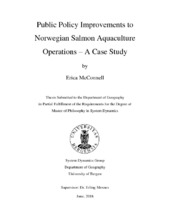Public Policy Improvements to Norwegian Salmon Aquaculture Operations – A Case Study
Master thesis
Permanent lenke
https://hdl.handle.net/1956/18269Utgivelsesdato
2018-06-29Metadata
Vis full innførselSamlinger
- Department of Geography [634]
Sammendrag
The aquaculture industry is an important food production industry both in Norway and around the world. As a young industry, it is still developing and growing. Industry-wide challenges exist, including but not limited to idle capacity, lice infestations, an inability to reach the maximum allowed fish biomass and long and risky periods of salmon growth in the sea. This paper focuses on public policy solutions which when implements would improve the problematic behaviour in the industry. To study these challenges, a model has been constructed, using the method of system dynamics. The model is a case study, and is built based on the real-life aquaculture operation of Osland Havbruk AS in the Sogn og Fjordane region of Norway. This model first reproduces the normal behaviour of the fish farm, and pinpoints the location of the problems in the operation. Then, the model is tested for validity, compared to real-life data and analyzed to ensure it is recreating the correct behaviour for the correct reasons. Policies are then created and experimented with which help improve the problematic behaviour of idle capacity, not reaching the maximum allowed biomass and long periods of salmon growth in the sea. Though this paper focuses on public policy improvements, it also looks at the effects these would have on the population of lice in the fish farm.
